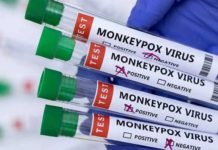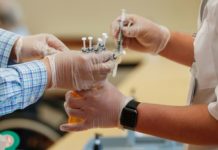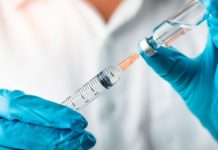The study did not meet its primary endpoint of PFS based on central radiologic review of the data (p=0.026 versus p=0.024 predefined). Findings demonstrated that everolimus plus octreotide LAR provided a clinically meaningful extension in the median time without tumor growth from 11.3 to 16.4 months when compared with placebo plus octreotide LAR (hazard ratio=0.77 [95% confidence interval, 0.59 to 1.00]; p=0.026)[1].
Further analyses of the study data were conducted using a well-established statistical model to adjust for imbalances in baseline characteristics between the two treatment arms and inconsistencies between the review of radiology scans for disease progression. The results show that everolimus plus octreotide LAR provided a statistically significant reduction in the risk of disease progression by 40% (hazard ratio=0.60 [95% confidence interval, 0.44 to 0.84]; p=0.0014) versus octreotide LAR alone[1].
Patients examined in the study had advanced NET that originated in the gastrointestinal (GI) tract, lungs and other locations in the body[1], also known as carcinoid tumors, which are the most common form of NET[3]. Neuroendocrine tumors are a rare cancer that can cause symptoms such as flushing and diarrhea[4]. Most patients with NET are not diagnosed until their disease has advanced, meaning the cancer has spread to other parts of the body and has become more difficult to treat[5]. Patients with advanced NET usually have a five year survival rate of less than 35%[6].
“A key goal of treating patients with advanced NET is to extend time without tumor growth,” said Prof Marianne Pavel, MD, Leader, Section for Neuroendocrine Tumors and Clinical Trial Unit in Neuroendocrine Tumors, Charité University Medicine, Berlin, and primary investigator of the RADIANT-2 trial. “This Phase III study is important because it shows that everolimus plus octreotide LAR may provide a viable new treatment approach for patients with advanced NET, where there is a high unmet need.”
Results from the Phase III RADIANT-3 trial, which were also presented at the ESMO Congress, show that everolimus more than doubled median time without tumor growth from 4.6 to 11.0 months when compared with placebo in patients with advanced pancreatic NET (hazard ratio=0.35 [95% confidence interval, 0.27 to 0.45]; p<0.0001)[7]. Findings from this study were also presented earlier this year at the 12th World Congress on Gastrointestinal Cancer in Barcelona.
“Results from the RADIANT trials, the largest and broadest in patients with advanced NET, will form the basis for regulatory filings later this year and demonstrate the ongoing commitment Novartis has to the NET community,” said Hervé Hoppenot, President, Novartis Oncology.
About RADIANT-2
RADIANT-2 is a Phase III randomized, double-blind, placebo-controlled, multicenter study. The trial examined the efficacy and safety of everolimus plus octreotide LAR versus placebo plus octreotide LAR in 429 patients with advanced NET. Patients who met the study’s entry criteria were randomized 1:1 to receive either everolimus (10 mg daily) plus octreotide LAR (30 mg intramuscularly every 28 days) or placebo daily plus octreotide LAR. Patients had radiological documentation of disease progression within 12 months prior to randomization[1].
The primary endpoint of RADIANT-2 is PFS. Secondary endpoints from the trial include safety, overall response rate and overall survival[1].
In the initial review of the data an imbalance in baseline characteristics was observed between the two treatment arms, including prior treatment with chemotherapy, primary tumors located in the lung and a poorer World Health Organization (WHO) performance status (an assessment of each patient’s functional/physical performance). Further, inconsistencies were found between analyses of radiology scans, which resulted in censoring of patients from the trial. These imbalances and the censoring of data seem to favor the control arm and may have impacted the outcome of the study. A well established statistical model, inverse probability of censoring weighted analysis, was used to adjust for the imbalances and censoring[1].
In the study, the most frequent all grade drug-related adverse events with everolimus plus octreotide LAR were stomatitis, rash, fatigue and diarrhea; most were grade one or two. Grade three and four adverse events (=5%) with everolimus plus octreotide LAR were stomatitis (6.5%), fatigue (6.5%), diarrhea (6%), infections/infestations (5.1%) and hyperglycemia (5.1%)[1].
About RADIANT-3
RADIANT-3 is a Phase III prospective, double-blind, randomized, parallel group, placebo-controlled, multicenter study. The trial examined the efficacy and safety of everolimus plus best supportive care (BSC) versus placebo plus BSC in 410 patients with advanced pancreatic NET, also known as islet cell tumors. Patients who met the study entry criteria were randomized 1:1 to receive either daily everolimus (10 mg) or daily placebo orally[7].
The primary endpoint of RADIANT-3 is PFS. Secondary endpoints include safety, objective response rate and overall survival[7].
In the study, the most frequent all grade drug-related adverse events with everolimus were stomatitis (64%), rash (53%), diarrhea (34%), fatigue (31%) and infections (23%); most were grade one or two. Stomatitis (6.9%), anemia (6%) and hyperglycemia (5%) were the most common grade three or four events. Median exposure to everolimus was 2.3-fold longer than exposure to placebo (38 versus 16 weeks)[7].
About neuroendocrine tumors (NET)
Neuroendocrine tumors arise from cells that can produce and secrete a variety of hormones that regulate bodily functions[8]. There are many types of NET that can occur throughout the body; however, most are found in the GI tract, pancreas and lungs[6],[9].
Because NET are relatively rare, there is no routine screening and patients often experience delays of five to seven years before receiving an accurate diagnosis. As a result of this, patients with NET often have advanced disease when diagnosed. The most recent available data show that in 2004, NET were diagnosed in approximately five cases per 100,000 per year. Although considered a rare cancer, the incidence of NET is increasing dramatically, having more than quadrupled in the past 30 years[5],[6].
About Afinitor (everolimus)
Approved in more than 55 countries globally, Afinitor® (everolimus) tablets is approved in the European Union (EU) for the treatment of patients with advanced renal cell carcinoma (RCC) whose disease has progressed on or after treatment with vascular endothelial growth factor (VEGF)-targeted therapy. In the United States (US), Afinitor is approved for the treatment of patients with advanced RCC after failure of treatment with sunitinib or sorafenib.
In the EU, everolimus is available in different dosage strengths under the trade name Certican® for the prevention of organ rejection in heart and kidney transplant recipients. In the US, everolimus is available in different dosage strengths under the trade name Zortress® for the prophylaxis of organ rejection in adult patients at low-moderate immunologic risk receiving a kidney transplant.
With once-daily dosing Afinitor works by targeting mTOR in cancer cells, a protein that acts as an important regulator of tumor cell division, blood vessel growth and cell metabolism.
As an investigational compound the safety and efficacy profile of everolimus has not yet been established in NET. Access to everolimus for NET has been carefully controlled and monitored in clinical trials designed to better understand the potential benefits and risks of the compound. For more information about ongoing everolimus clinical trials, healthcare professionals can visit www.theWIDEprogram.com. Because of the uncertainty of clinical trials, there is no guarantee that everolimus will become commercially available for NET anywhere in the world.
Afinitor (everolimus) tablets important safety information
Afinitor is contraindicated in patients with hypersensitivity to everolimus, to other rapamycin derivatives or to any of the excipients.
Cases of non-infectious pneumonitis have been described; some of these have been severe and occasionally fatal. Management of pneumonitis may require dose adjustment and/or interruption, or discontinuation of treatment and/or addition of corticosteroid therapy.
Afinitor is immunosuppressive. Localized and systemic bacterial, fungal, viral or protozoal infections (e.g., pneumonia, aspergillosis, candidiasis, hepatitis B reactivation) have been described; some of these have been severe and occasionally fatal. Pre-existing infections should be treated prior to starting treatment. Patients and physicians should be vigilant for symptoms and signs of infection; in case of emergent infections, appropriate treatment should be promptly instituted and interruption or discontinuation of Afinitor should be considered. Patients with systemic invasive fungal infections should not receive Afinitor.
Mouth ulcers, stomatitis and oral mucositis have been seen in patients treated with Afinitor. Monitoring of renal function, blood glucose and complete blood counts is recommended prior to initiation and periodically during treatment.
Afinitor is not recommended in patients with severe hepatic impairment. Use of live vaccines should be avoided. Afinitor is not recommended during pregnancy or for women of childbearing potential not using contraception. Afinitor may cause fetal harm in pregnant women. Women taking Afinitor should not breast feed.
Avoid concurrent treatment with strong CYP3A4 and PgP inhibitors and use caution with moderate inhibitors. Avoid concurrent treatment with strong CYP3A4 or PgP inducers.
The most common adverse reactions (=10%) include stomatitis, rash, fatigue, asthenia, diarrhea, anorexia, nausea, mucosal inflammation, vomiting, cough, infections, peripheral edema, dry skin, epistaxis, pneumonitis, pruritus, dyspnea and dysgeusia. Common adverse reactions (=1 to <10%) include headache, dry mouth, pyrexia, weight loss, hand-foot syndrome, abdominal pain, erythema, insomnia, dyspepsia, dysphagia, hypertension, increased daytime urination, dehydration, chest pain, hemoptysis and exacerbation of diabetes mellitus. Uncommon adverse reactions (<1%) include ageusia, congestive cardiac failure, new-onset diabetes mellitus, impaired wound healing, grade 1 hemorrhage and hepatitis B reactivation.
About Sandostatin LAR
Sandostatin® LAR® is a long-acting, injectable depot formulation of octreotide acetate that is indicated for the treatment of patients with acromegaly who are adequately controlled on s.c. treatment with Sandostatin; in whom surgery or radiotherapy is inappropriate or ineffective; or in the interim period until radiotherapy becomes fully effective and for the treatment of patients with symptoms associated with functional GEP-NET in whom symptoms are adequately controlled on s.c. treatment with Sandostatin.
Sandostatin LAR was first approved in France in June 1995 and is currently approved in 85 countries. For more than a decade, Sandostatin LAR has achieved a long-standing track record of sustained efficacy with a well-established safety profile.
About Novartis
Novartis provides healthcare solutions that address the evolving needs of patients and societies. Focused solely on healthcare, Novartis offers a diversified portfolio to best meet these needs: innovative medicines, cost-saving generic pharmaceuticals, preventive vaccines, diagnostic tools and consumer health products. Novartis is the only company with leading positions in these areas. In 2009, the Group’s continuing operations achieved net sales of USD 44.3 billion, while approximately USD 7.5 billion was invested in R&D activities throughout the Group. Headquartered in Basel, Switzerland, Novartis Group companies employ approximately 102,000 full-time-equivalent associates and operate in more than 140 countries around the world. For more information, please visit http://www.novartis.com.


























